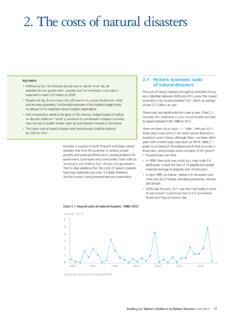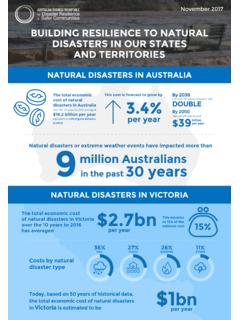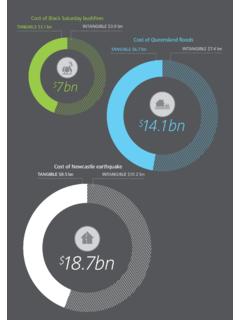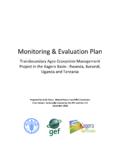Transcription of 3. Roles and responsibilities in disaster management
1 23 Building our Nation s Resilience to Natural Disasters June Recent inquiries and reviewsThe prevailing principles of disaster management in Australia (prevention, preparedness, response and recovery) are evolving. Recent inquiries and reviews have highlighted the vital role of resilience in disaster management planning. Since 2009 there have been a number of Inquiries/Reviews related to Natural Disasters, including: The Victorian Bushfires Royal Commission The Queensland Floods Commission of Inquiry The Australian Government s Natural disaster Insurance Review Productivity Commission Inquiry into Regulatory and Policy Barriers to Effective climate change adaptation Treasury Consultation Paper Reforming Flood Insurance: Clearing the Waters The Australian Government s Consultation Paper, Reforming flood insurance.
2 A proposal to improve availability and transparency The Federal Parliamentary Inquiry into the operation of the insurance industry during disaster events The Federal Parliamentary Inquiry into Residential Strata Title Insurance Australian Government Actuary Report On Investigation into Strata Title Insurance Price Rises in North Queensland Senate Inquiry into Extreme Weather Frequency and reviews and inquiries outline an extensive list of recommendations and suggested courses of action for the Australian Government, state and local governments, and communities. While some of the recommendations have already been accepted and implemented, many remain in the consultation and planning phases.
3 This suggests that, while disaster resilience is placed high on the agenda for future action, the issues are challenging and take time to resolve. In particular, actions which require the coordination of communities, local governments, state and the Australian Governments are less likely to have been completed. Chart demonstrates that, while most of the recommendations of inquiries have been considered and many are in progress, a majority remain incomplete6. Chart : Reviews and Inquiries: recommendations yet to be completed3. Roles and responsibilities in disaster managementCompleteIn progressNo actionNational Strategy for disaster ResilienceVictorian Bushfires Royal CommissionQueensland Flood Commission of InquiryEmergency Architects Australia reviewInquiry into Flood Mitigation in Victoria2084101266 The recommendations highlighted in the above chart include those that are related to the case studies outlined in Chapter 4.
4 The reviews that were included in this analysis are: National Strategy for disaster Resilience, National disaster Insurance Review, Victorian Bushfires Royal Commission, Queensland Flood Commission of Inquiry, Queensland Flood Relief Emergency Architects Australia, Brisbane backflow prevention measures investigation, Inquiry into Flood Mitigation in Victoria, Cyclone Testing Station. The bulk of the recommendations included in the Reviews and Inquiries relate to improvements in dealing with the disaster response and disaster recovery matters, only some of the recommendations are directly related to resilience.
5 The Emergency Architects Australia report was an independent submission to the Queensland Floods Commission of Inquiry. The recommendations included in Chart pertain to structures in flood prone areas, which are difficult to implement. key Points disaster management in Australia involves a complex range of stakeholders and activities There have been a number of reviews and inquiries undertaken at the federal and state government levels producing a wealth of information and insight into specific disaster events However, implementing recommendations related to pre- disaster resilience has been slow While some funding has been provided for pre- disaster resilience.
6 The ratio of pre- disaster resilience funding to funding during and following disasters is Current policy frameworkCOAG plays an important role in coordinating government responses to both natural disasters and human-caused risks to personal and community safety. Responding to disasters is an existing issue under the COAG agenda for National Security and Community Safety. In 2011 COAG endorsed the resilience-based approach to emergency management , the National Strategy for disaster Resilience. However, there are also elements of pre- disaster resilience that reside within all current COAG reform agendas.
7 Along with NSDR, there is the National disaster Resilience Framework, Critical Infrastructure Resilience Strategy, and the National climate change adaptation Action plan as well as bodies such as the Australia New Zealand Emergency management Committee, Trusted Information Sharing Network, the climate Commission and the newly created National Insurance Affordability Council. The fact that the scope of pre- disaster resilience spreads across a number of different agendas demonstrates the current fragmented nature of pre- disaster resilience and therefore the need for a fresh, sustainable and comprehensive national the NSDR, the current policy framework has recognised that disaster resilience is a shared responsibility for individuals, households, businesses and communities, as well as for governments.
8 As outlined in the first chapter, the Roles and responsibilities of the key stakeholders have been clearly articulated by government7: Building resilience should be assigned to those most appropriate to respond to local conditions; this will favour local initiatives and private responsibility where resilience has no external effects on third parties. That is, private parties will continue to take responsibility for their own actions, assets, investments and risks. Governments should respond to market failures and regulatory failures that prevent effective and efficient natural disaster risk management , focusing on.
9 Providing best available information about risks to facilitate adaptation by the private sector and making information accessible and useable Ensuring that regulations, markets and institutions promote effective private risk management Managing risks to public goods/assetsand government service delivery Taking account of disaster risk in policy and planning Helping build capacity and resilience, where required, particularly to assist vulnerable individuals, groups, regions and communities. Decision-making should: Be based on the best available research Be cost-effective Be regularly reviewed to meet changing circumstances Enhance social on this approach, the remainder of this chapter outlines the Roles and responsibilities of key stakeholders, focusing on the activities that they currently In November 2012, the COAG Select Council on climate change (SCCC) developed a set of guiding principles for the Roles and responsibilities of key stakeholders that in this instance have been applied to pre- disaster resilience for natural disasters.
10 25 Building our Nation s Resilience to Natural Disasters June Australian GovernmentFigure demonstrates the current spread of Australian Government resilience activities across departments and governmental bodies. The range and breadth of activities attests to the importance of resilience in the broader policy : The current Australian Government approach to resilience in Australia The Attorney General s Department, with its responsibility for Emergency management Policy, is the core Australian Government department relating to disaster resilience. The Responding to Disasters COAG agenda is administered through the Standing Council on Police and Emergency management (SCPEM) and the Australian New Zealand Emergency management Committee (ANZEMC).




